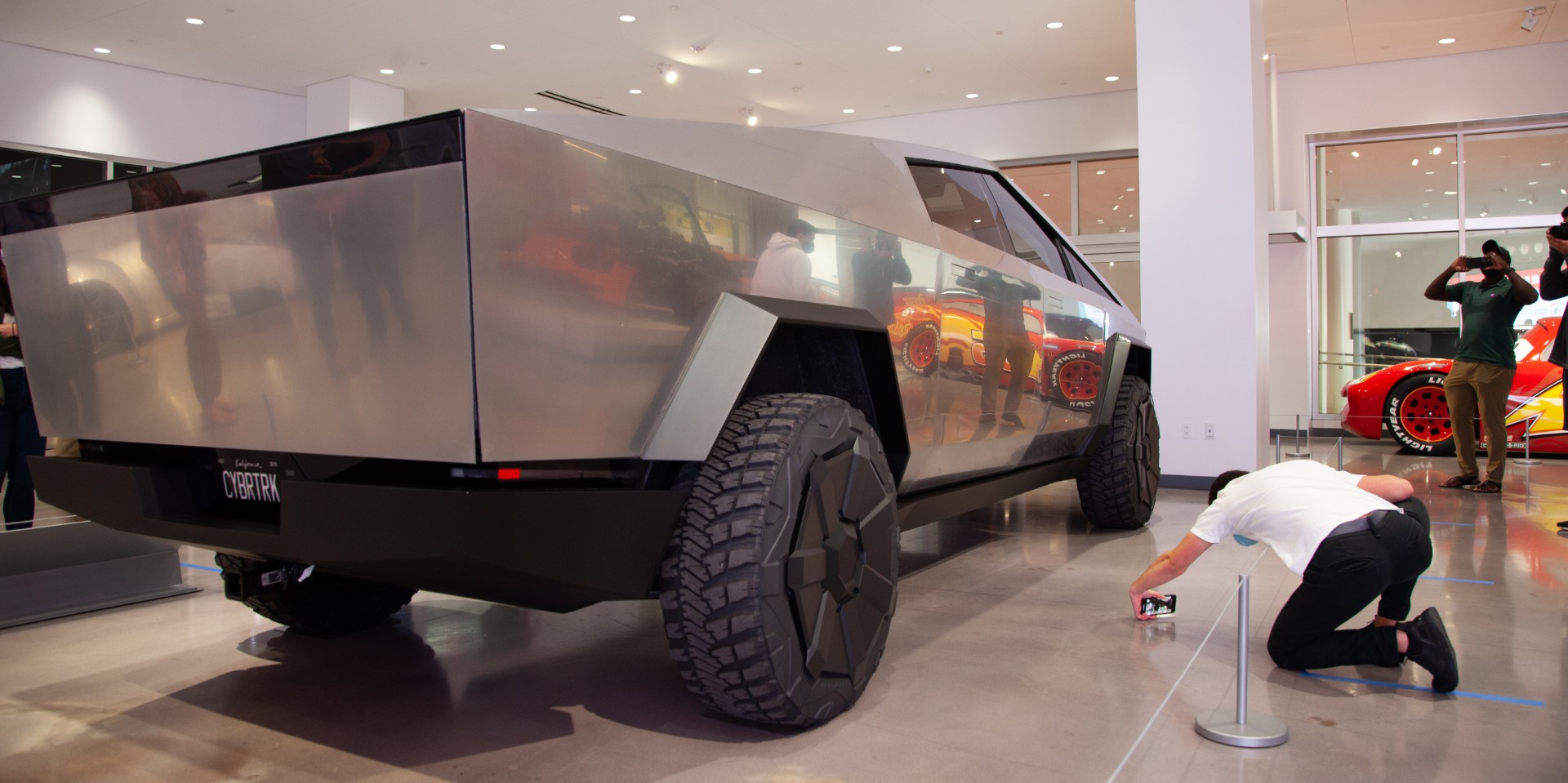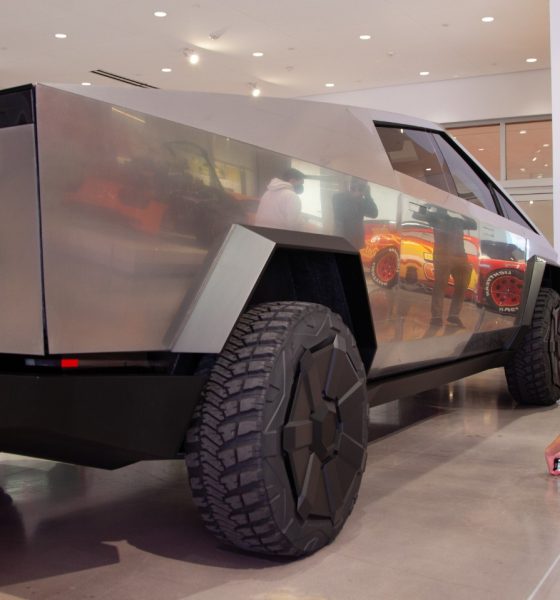The first all-electric trucks from new car companies and veteran automakers are yet to start consumer deliveries, but this has not stopped truckmaker Nikola from throwing some good old-fashioned shade at one of its competitors. In comments during its inaugural quarterly earnings call, CEO Mark Russell stated that part of the reason behind the company’s decision to release the Nikola Badger pickup is due to the Cybertruck’s “doorstop” appearance.
According to the CEO, Nikola actually did not have plans to produce a zero-emissions pickup a year ago. The company had a concept for a pickup truck, but it did not really intend to do anything with it. That is, at least, until Tesla unveiled the Cybertruck. And as it turned out, the Cybertruck’s looks just happened to be very, very polarizing.
“A year ago we didn’t believe we would be building a pickup truck. We had built several off-road vehicle prototypes and had a concept for a pickup truck. We didn’t intend to do anything with it until we saw the Cybertruck. A lot of people didn’t like the look of the Cybertruck, including me. I think it looks like a doorstop, but they got lots of reservations for it, so more power to them,” Russell said.
That being said, pickup trucks like the Badger will likely be more of a sideline business for Nikola due to the company’s focus on zero-emissions long-haulers like the all-electric Nikola Tre and the hydrogen-powered Nikola Two. Nevertheless, Russell remarked that Nikola is currently close to naming its designated manufacturing partner for the Badger, and that an announcement on the topic will likely be held before the end of the year.
Interestingly enough, Nikola founder Trevor Milton actually offered the Badger’s design to Tesla CEO Elon Musk following the Cybertruck’s unveiling last November. In a post on Twitter, Milton noted that he would be happy to donate Nikola’s pickup design if Tesla wishes to hit a broader market. But after over 89,000 people signed up online for more information about Nikola’s zero-emissions pickup, Russell explained that the company opted to move forward with the vehicle’s production and release.
Tesla CEO Elon Musk has been pretty transparent with the Cybertruck’s design, noting even before the vehicle’s unveiling that the all-electric pickup will not be for everyone. In a recent interview with Automotive News, Musk remarked that if the Cybertruck would end up failing, Tesla would simply make a more conventional all-electric pickup. “If it turns out nobody wants to buy a weird-looking truck, we’ll build a normal truck, no problem,” Musk said.
The Tesla Cybertruck is currently available for a refundable $100 deposit. Nikola, on the other hand, is currently offering reservations for the Badger that range from $250 to $5,000 each. Reservations for the Badger started on June 29, 2020, though the CEO did not disclose how many reservations it has received to date. For his part, Russell stated that he is looking forward to competing with the Tesla Cybertruck in the pickup truck market. “We’re trying to get the whole world to zero” emissions. It’s gonna take more than us so we cheer (Musk) on. But a lot of people didn’t like the look of that thing,” the CEO said.

Elon Musk
Elon Musk and Tesla AI Director share insights after empty driver seat Robotaxi rides
The executives’ unoccupied tests hint at the rapid progress of Tesla’s unsupervised Robotaxi efforts.

Tesla CEO Elon Musk and AI Director Ashok Elluswamy celebrated Christmas Eve by sharing personal experiences with Robotaxi vehicles that had no safety monitor or occupant in the driver’s seat. Musk described the system’s “perfect driving” around Austin, while Elluswamy posted video from the back seat, calling it “an amazing experience.”
The executives’ unoccupied tests hint at the rapid progress of Tesla’s unsupervised Robotaxi efforts.
Elon and Ashok’s firsthand Robotaxi insights
Prior to Musk and the Tesla AI Director’s posts, sightings of unmanned Teslas navigating public roads were widely shared on social media. One such vehicle was spotted in Austin, Texas, which Elon Musk acknowleged by stating that “Testing is underway with no occupants in the car.”
Based on his Christmas Eve post, Musk seemed to have tested an unmanned Tesla himself. “A Tesla with no safety monitor in the car and me sitting in the passenger seat took me all around Austin on Sunday with perfect driving,” Musk wrote in his post.
Elluswamy responded with a 2-minute video showing himself in the rear of an unmanned Tesla. The video featured the vehicle’s empty front seats, as well as its smooth handling through real-world traffic. He captioned his video with the words, “It’s an amazing experience!”
Towards Unsupervised operations
During an xAI Hackathon earlier this month, Elon Musk mentioned that Tesla owed be removing Safety Monitors from its Robotaxis in Austin in just three weeks. “Unsupervised is pretty much solved at this point. So there will be Tesla Robotaxis operating in Austin with no one in them. Not even anyone in the passenger seat in about three weeks,” he said. Musk echoed similar estimates at the 2025 Annual Shareholder Meeting and the Q3 2025 earnings call.
Considering the insights that were posted Musk and Elluswamy, it does appear that Tesla is working hard towards operating its Robotaxis with no safety monitors. This is quite impressive considering that the service was launched just earlier this year.
Elon Musk
Starlink passes 9 million active customers just weeks after hitting 8 million
The milestone highlights the accelerating growth of Starlink, which has now been adding over 20,000 new users per day.

SpaceX’s Starlink satellite internet service has continued its rapid global expansion, surpassing 9 million active customers just weeks after crossing the 8 million mark.
The milestone highlights the accelerating growth of Starlink, which has now been adding over 20,000 new users per day.
9 million customers
In a post on X, SpaceX stated that Starlink now serves over 9 million active users across 155 countries, territories, and markets. The company reached 8 million customers in early November, meaning it added roughly 1 million subscribers in under seven weeks, or about 21,275 new users on average per day.
“Starlink is connecting more than 9M active customers with high-speed internet across 155 countries, territories, and many other markets,” Starlink wrote in a post on its official X account. SpaceX President Gwynne Shotwell also celebrated the milestone on X. “A huge thank you to all of our customers and congrats to the Starlink team for such an incredible product,” she wrote.
That growth rate reflects both rising demand for broadband in underserved regions and Starlink’s expanding satellite constellation, which now includes more than 9,000 low-Earth-orbit satellites designed to deliver high-speed, low-latency internet worldwide.
Starlink’s momentum
Starlink’s momentum has been building up. SpaceX reported 4.6 million Starlink customers in December 2024, followed by 7 million by August 2025, and 8 million customers in November. Independent data also suggests Starlink usage is rising sharply, with Cloudflare reporting that global web traffic from Starlink users more than doubled in 2025, as noted in an Insider report.
Starlink’s momentum is increasingly tied to SpaceX’s broader financial outlook. Elon Musk has said the satellite network is “by far” the company’s largest revenue driver, and reports suggest SpaceX may be positioning itself for an initial public offering as soon as next year, with valuations estimated as high as $1.5 trillion. Musk has also suggested in the past that Starlink could have its own IPO in the future.
News
NVIDIA Director of Robotics: Tesla FSD v14 is the first AI to pass the “Physical Turing Test”
After testing FSD v14, Fan stated that his experience with FSD felt magical at first, but it soon started to feel like a routine.

NVIDIA Director of Robotics Jim Fan has praised Tesla’s Full Self-Driving (Supervised) v14 as the first AI to pass what he described as a “Physical Turing Test.”
After testing FSD v14, Fan stated that his experience with FSD felt magical at first, but it soon started to feel like a routine. And just like smartphones today, removing it now would “actively hurt.”
Jim Fan’s hands-on FSD v14 impressions
Fan, a leading researcher in embodied AI who is currently solving Physical AI at NVIDIA and spearheading the company’s Project GR00T initiative, noted that he actually was late to the Tesla game. He was, however, one of the first to try out FSD v14.
“I was very late to own a Tesla but among the earliest to try out FSD v14. It’s perhaps the first time I experience an AI that passes the Physical Turing Test: after a long day at work, you press a button, lay back, and couldn’t tell if a neural net or a human drove you home,” Fan wrote in a post on X.
Fan added: “Despite knowing exactly how robot learning works, I still find it magical watching the steering wheel turn by itself. First it feels surreal, next it becomes routine. Then, like the smartphone, taking it away actively hurts. This is how humanity gets rewired and glued to god-like technologies.”
The Physical Turing Test
The original Turing Test was conceived by Alan Turing in 1950, and it was aimed at determining if a machine could exhibit behavior that is equivalent to or indistinguishable from a human. By focusing on text-based conversations, the original Turing Test set a high bar for natural language processing and machine learning.
This test has been passed by today’s large language models. However, the capability to converse in a humanlike manner is a completely different challenge from performing real-world problem-solving or physical interactions. Thus, Fan introduced the Physical Turing Test, which challenges AI systems to demonstrate intelligence through physical actions.
Based on Fan’s comments, Tesla has demonstrated these intelligent physical actions with FSD v14. Elon Musk agreed with the NVIDIA executive, stating in a post on X that with FSD v14, “you can sense the sentience maturing.” Musk also praised Tesla AI, calling it the best “real-world AI” today.










